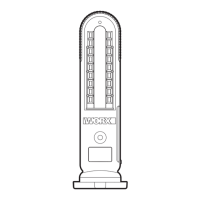4
EN
12V Multifunction Jump Starter with LED
Lights
may cause explosion.
5. Remove personal metal items such as rings,
bracelets, necklaces and watches when working
with a lead-acid battery. A lead-acid battery can
produce a short-circuit current high enough to
weld a ring or the like to metal, causing a severe
burn.
6. Use the jump starter for jump starting lead-acid
batteries only. Do not use for charging dry-cell
batteries that are commonly used with home
appliances. These batteries may burst and cause
injury to persons and damage to property.
7. NEVER charge or jump start a frozen battery.
8. To prevent arcing, NEVER allow clamps to touch
together or to contact the same piece of metal.
9. Do not disassemble, bump, squeeze, puncture or
penetrate the product.
10. Keep jump starter dry, clean and oil-free. Be sure
to use a clean cloth when cleaning and do not use
any corrosive solvent.
INFORMATION FOR
RADIATED EMISSION
This device complies with Canadian ICES-001.
This device complies with Part 15 of the FCC Rules.
Operation is subject to the following two conditions:
(1) This device may not cause harmful interference,
and
(2) This device must accept any interference
received, including interference that may cause
undesired operation.
Warning: Changes or modifications to this unit
not expressly approved by the party responsible
for compliance could void the user’s authority to
operate the equipment.
- NOTE: This equipment has been tested and found
to comply with the limits for a Class B digital
device, pursuant to Part 15 of the FCC Rules.
These limits are designed to provide reasonable
protection against harmful interference in a
residential installation. This equipment generates,
uses and can radiate radio frequency energy and,
if not installed and used in accordance with the
instructions, may cause harmful interference to
radio communications.
However, there is no guarantee that interference
will not occur in a particular installation. If this
equipment does cause harmful interference
to radio or television reception, which can be
determined by turning the equipment off and
on, the user is encouraged to try to correct the
interference by one or more of the following
measures:
• Reorient or relocate the receiving antenna.
• Increase the separation between the equipment
and receiver.
• Connect the equipment into an outlet on a
circuit different from that to which the receiver is
connected.
• Consult the dealer or an experienced radio/TV
technician for help.
SAFETY WARNINGS FOR
BATTERY CELLS INSIDE
THE TOOL
a) Do not dismantle, open or shred cells.
b) Do not expose power tool to heat or fire.
Avoid storage in direct sunlight.
c) Do not short-circuit charging terminal. Do
not store power tool haphazardly in a box or
drawer where charging terminal may short-
circuit each other or be short-circuited by
conductive materials. When power tool is not
in use, keep it away from other metal objects, like
paper clips, coins, keys, nails, screws or other
small metal objects, that can make a connection
from one charging terminal to another. Shorting
the battery terminals together may cause burns or
fire.
d) Do not remove power tool from its original
packaging until required for use.
e) Do not subject power tool to mechanical
shock.
f) In the event of battery leaking, do not allow
the liquid to come in contact with the skin
or eyes. If contact has been made, wash
the affected area with copious amounts of
water and seek medical advice.
g) Observe the plus (+) and minus (–) marks on
the equipment and ensure correct use.
h) Keep power tool out of the reach of
children.
i) Seek medical advice immediately if a cell
has been swallowed.
j) Keep power tool clean and dry.
k) Wipe the charging terminals with a clean
dry cloth if they become dirty.
l) Power tool need to be charged before
use. Always use the correct charger and
refer to the manufacturer’s instructions
or equipment manual for proper charging
instructions.
m) Do not leave power tool on prolonged
charge when not in use.
n) After extended periods of storage, it may
be necessary to charge and discharge
the power tool several times to obtain
maximum performance.
o) Battery gives its best performance when it
is operated at normal room temperature (20
°C ± 5 °C).
p) When disposing of cells, keep cells of
different electrochemical systems separate
from each other.
q) Recharge only with the charger specified
by Worx. Do not use any charger other than
that specifically provided for use with the
equipment. A charger that is suitable for one
type of battery may create a risk of fire when used
with another battery.
r) Retain the original product literature for
future reference.
s) Dispose of properly.

